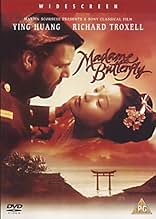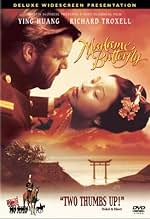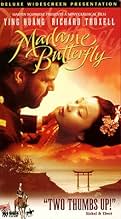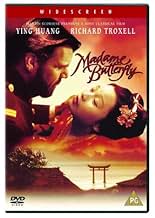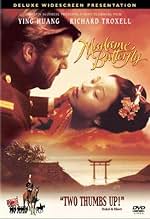Madame Butterfly
- 1995
- Tous publics
- 2h 15m
IMDb RATING
7.0/10
658
YOUR RATING
The story of a young geisha who falls madly in love with an american captain that travels all around the world collecting hearts.The story of a young geisha who falls madly in love with an american captain that travels all around the world collecting hearts.The story of a young geisha who falls madly in love with an american captain that travels all around the world collecting hearts.
- Director
- Writers
- Stars
- Awards
- 1 win & 1 nomination total
- Director
- Writers
- All cast & crew
- Production, box office & more at IMDbPro
Featured reviews
This really is a great opera movie. All the actors have the right age and -when it comes to appearance- the right "beauty". Butterfly is a young girl in the story, and in this movie she looks as one (and she is only in her early twenties). Nevertheless she does all the singing herself. She has won prizes in opera competitions and is very convincing. She is from China, not Japan, and has the perfect voice for the part. Who would ever find this story believable with a 40-years old soprano? Now with this young Asian actress/singer one is moved as one should be. Not only the singing, but also the emotions are clear and real. This could never be achieved in play-back from a different singer. All the other main characters are (very) good actors and sing their own parts (very well). The setting is beautiful, though not in Japan, but in Tunisia (I read afterwards). The orchestra plays well (under James Conlon). In fact everything is good. Only a few minor parts are sung by different persons than the (Asian) actors. Summarizing: The best Butterfly I have ever seen and probably the best I will ever see from now on.
Mitterand's production of Madame Butterfly is an outstanding piece of movie-making. Handled so delicately, the film will have appeal to both opera lovers & movie buffs alike.An enchanting love story, beautiful singing, music by Puccini, an interesting set ( a "house of cards" atop a mountain with views of sea and sky) make for a handsome film. I like the opening sequence which quickly establishes the atmosphere of old Japan. We are introduced to the main character- Butterfly, a 15 year old Japanese girl whose family has fallen into poverty & B.F. Pinkerton, a naval officer, her self-assured American lover who treats her as a sexual plaything. Sacrificing all her ties with the Japanese way of life Butterfly agrees to marry Pinkerton. During the marriage celebrations her absent Uncle Bonzo appears magically suspended in the sky & he casts her into eternal damnation for renouncing her people and ancient rites. This is the only weak point in the movie. It's such a serious moment and yet I wanted to laugh. It's obvious that the three figures in the sky are suspended by wires (a bit jerky too). Why accept this when current cinemaphotography has reached such heights in producing supernatural effects? The characterisations are generally well-done. The part of Butterfly particularly appealing performed with such grace and sincerity. Pinkerton too makes a convincing thoughtless man of the world. In an early scene however he kneels on the floor and converses with Butterfly's maid. I thought this was quite wrong and out of character unless he was trying to ridicule the Japanese customs.When eventually Butterfly becomes pregnant, a son is born, but by now Pinkerton is back in America. For three years she awaits his return. There are some very moving scenes at this point. Finally Pinkerton returns to Nagasaki with an American wife ("a real wife" he calls her). There is a poignant scene when the devoted Butterfly relinquishes her son to Pinkerton's wife. He will go back to the States and be educated there. What future is there for Butterfly? (Tissues may be required at this point!)The ending is heart-rending. I am not a particular lover of opera but after this exciting experience I am ready for more.
Filming an opera, especially one as globally well known as Puccini's, is a daunting challenge because so much of what has been composed and dramatized has been designed specifically for the stage of an opera hall. On one end, there have been superb video recordings of great stage performances, such as the 2005 Salzburg Festival production of Verdi's "La Traviata" with Anna Netrebko and Rolando Villazón. On the other end are adaptations that try to cinematize operas with real locations, though most often with some deficiencies, for example, Barbara Willis Sweete's 2002 production of Gounod's "Roméo et Juliette" with Roberto Alagna and Angela Gheorghiu frankly too old to play the young lovers. In the latter camp, this 1995 French-financed film shows director Frédéric Mitterand making a valid attempt toward authenticity, but he misses a key opportunity to open up the visual and sensory possibilities beyond the obvious. Despite the creative use of Tunisian locations to replicate early 1900's Japan, the result still feels oddly stage-bound and dramatically inert despite some bravura musical moments.
The heavily masochistic story is familiar. In 1904, U.S. naval officer Lieutenant Pinkerton, while stationed in Nagasaki, marries a teenaged girl named Cio-Cio San. Despite their affections for one another, he cavalierly sees the marriage as one of convenience, and when his assignment is done, he goes back to the U.S. with no intention of returning. Cio-Cio San, however, takes the relationship so seriously that she sacrifices her family for the marriage. Three years pass by, but it does not deter Cio-Cio San from hoping for Pinkerton's return since it turns out that she has borne their son in the meantime. Finally, a ship arrives and Cio-Cio San correctly surmises that he is on it. However, tragedy ensues since Pinkerton has remarried in the interim and wants to take his son back to America with him and his new American wife. Taken on the surface, the opera seems defiantly anti-American in showing Pinkerton to be a superficial cad despite how remorseful he may appear at the end, but it also takes a sideswipe at the purportedly subservient nature of Japanese women since her own self-delusions are so intractable. Regardless, the heartstrings are pulled at the right moments when the opera is acted in the manner Puccini intended.
Chinese soprano Ying Huang was chosen over hundreds of young singers for the title role, and while she does not really look Japanese, she displays a sweetly supple voice as she performs the dramatic arc of Cio-Cio San's plight. However, as a screen actress, Huang lacks a certain lightness in the early romantic scenes and seems a bit at sea with the later melodramatic moments. Even though she lacks the plummy depths of a Callas or a Tebaldi, she provides affecting renditions of the two pivotal arias, "Un bel dì vedremo" when Cio-Cio San looks out into the harbor awaiting Pinkerton's return, and her death scene, "Con onor muore". As Pinkerton, admittedly a tough role to play much less sympathize with, American tenor Richard Traxell matches Huang well vocally, but again his acting seems a bit shallow as he only shows unrelenting bravado in the first act and guilt-ridden regret in the third. The others in the cast fare better since there are less dramatic demands on them, in particular, American baritone Richard Cowan as the sympathetic consul Sharpless and acclaimed Chinese mezzo-soprano Liang Ning as the maid Suzuki.
Despite some nice art direction, the visual presentation feels somewhat flat when colors should really pop and the camera be more mobile. There are also some scenes that simply do not work such as having Cio-Cio San's uncles come to banish her from the family in an airborne fashion and the use of anachronistic Japanese newsreel footage as a musical bridge. However, the sound itself is fine with superb orchestral support from the Orchestre de Paris under the baton of James Conlon. There is one extra with the 2002 DVD, a 12-minute making-of featurette which really amounts to following Huang from her initial audition through the actual production.
The heavily masochistic story is familiar. In 1904, U.S. naval officer Lieutenant Pinkerton, while stationed in Nagasaki, marries a teenaged girl named Cio-Cio San. Despite their affections for one another, he cavalierly sees the marriage as one of convenience, and when his assignment is done, he goes back to the U.S. with no intention of returning. Cio-Cio San, however, takes the relationship so seriously that she sacrifices her family for the marriage. Three years pass by, but it does not deter Cio-Cio San from hoping for Pinkerton's return since it turns out that she has borne their son in the meantime. Finally, a ship arrives and Cio-Cio San correctly surmises that he is on it. However, tragedy ensues since Pinkerton has remarried in the interim and wants to take his son back to America with him and his new American wife. Taken on the surface, the opera seems defiantly anti-American in showing Pinkerton to be a superficial cad despite how remorseful he may appear at the end, but it also takes a sideswipe at the purportedly subservient nature of Japanese women since her own self-delusions are so intractable. Regardless, the heartstrings are pulled at the right moments when the opera is acted in the manner Puccini intended.
Chinese soprano Ying Huang was chosen over hundreds of young singers for the title role, and while she does not really look Japanese, she displays a sweetly supple voice as she performs the dramatic arc of Cio-Cio San's plight. However, as a screen actress, Huang lacks a certain lightness in the early romantic scenes and seems a bit at sea with the later melodramatic moments. Even though she lacks the plummy depths of a Callas or a Tebaldi, she provides affecting renditions of the two pivotal arias, "Un bel dì vedremo" when Cio-Cio San looks out into the harbor awaiting Pinkerton's return, and her death scene, "Con onor muore". As Pinkerton, admittedly a tough role to play much less sympathize with, American tenor Richard Traxell matches Huang well vocally, but again his acting seems a bit shallow as he only shows unrelenting bravado in the first act and guilt-ridden regret in the third. The others in the cast fare better since there are less dramatic demands on them, in particular, American baritone Richard Cowan as the sympathetic consul Sharpless and acclaimed Chinese mezzo-soprano Liang Ning as the maid Suzuki.
Despite some nice art direction, the visual presentation feels somewhat flat when colors should really pop and the camera be more mobile. There are also some scenes that simply do not work such as having Cio-Cio San's uncles come to banish her from the family in an airborne fashion and the use of anachronistic Japanese newsreel footage as a musical bridge. However, the sound itself is fine with superb orchestral support from the Orchestre de Paris under the baton of James Conlon. There is one extra with the 2002 DVD, a 12-minute making-of featurette which really amounts to following Huang from her initial audition through the actual production.
I love Madame Butterfly so naturally I wanted to see this 1995 film. And I am so glad I saw it, as it is a beautiful and excellent film of a wonderful opera. At hindsight, the opera's story is rather implausible, however the love story and telling of it is timeless, Cio Cio San is a charming lead character and the music(my favourites being Humming Chorus, Flower Duet, Un Bel Di Vedremo and particularly the act 1 love duet) is among Puccini's very finest.
There are only two things I wasn't crazy about here. One was showing the Gonze as a supernatural figure and floating in mid air, I personally found it unnecessary and felt it distracted from the drama of that particular moment. The other was the use of black and white footage of old Japan. In a way it was interesting, but I for one wasn't entirely sure whether it fitted with the scene(Humming Chorus in this case).
However, this film is visually stunning, with sweeping camera shots, stunning scenery and evocative costumes. The beautiful music is beautifully performed by the orchestra and is conducted with precision and sensitivity. When it comes to the acting/staging, the love duet was genuinely affecting and the Flower Duet blended and acted beguilingly, but the revelations were Un Bel Di Vedremo and the final scene, both of which moved me to tears.
The acting and singing work hugely too. Ying Huang amazed me with her beauty and appealing voice, and Richard Troxell is an excellent Pinkerton, never trying too hard to make us hate him. Ning Liang is one of the most sympathetic Suzukis I know of, and Sharpless shapes his music beautifully. Goro also is more cynical and less bumbling, something that I loved and found refreshing.
Overall, excellent film and one where a box of tissues by your side is necessary. 8/10 Bethany Cox
There are only two things I wasn't crazy about here. One was showing the Gonze as a supernatural figure and floating in mid air, I personally found it unnecessary and felt it distracted from the drama of that particular moment. The other was the use of black and white footage of old Japan. In a way it was interesting, but I for one wasn't entirely sure whether it fitted with the scene(Humming Chorus in this case).
However, this film is visually stunning, with sweeping camera shots, stunning scenery and evocative costumes. The beautiful music is beautifully performed by the orchestra and is conducted with precision and sensitivity. When it comes to the acting/staging, the love duet was genuinely affecting and the Flower Duet blended and acted beguilingly, but the revelations were Un Bel Di Vedremo and the final scene, both of which moved me to tears.
The acting and singing work hugely too. Ying Huang amazed me with her beauty and appealing voice, and Richard Troxell is an excellent Pinkerton, never trying too hard to make us hate him. Ning Liang is one of the most sympathetic Suzukis I know of, and Sharpless shapes his music beautifully. Goro also is more cynical and less bumbling, something that I loved and found refreshing.
Overall, excellent film and one where a box of tissues by your side is necessary. 8/10 Bethany Cox
Madame Butterfly is a beautiful, romantic and dramatic story. It is all about a fifteen years old geisha called Cio Cio-San, who gets married with the official of the American navy, Benjamim Franklin Pinkerton.
Pinkerton, the fiancé, is just buying a woman, as he did in other parts of the world, to be close in his moments of loneliness, while he doesn't marry a true American wife.
After three years of marriage, Pinkerton goes back to the United States, leaving Butterfly with a small son he never knew. Cio Cio San believes that her husband will return, and she refuses to assume her Japanese values and a new life.
During all the story, Cio Cio-San will always count with the unconditional friendship of the maid Suzuki.
To get things worst, Butterfly receives a letter of Pinkerton informing that he will not return anymore, making clear that he married an American woman. Butterfly interprets his words in an erroneous way, and she sees new hopes for of her husband arrival.
He returns, however, to look for his son.
The end of the plot shows the suicide of Butterfly, when noticing that she had lost everything that she loved, the husband and now also the son. (She had used as a weapon her father's sword, with the inscription: "To die with honor, when one can no longer live with honor". The now-humiliated, heartbroken daughter of a disgraced samurai, she dies proudly - as a samurai.)
The opera is tragic, because Cio Cio-San really believes in her illusions, and she only notices the mistakes very late.
There are difficulties, for example, how she was renounced by her relatives by converting Pinkerton's religion (Catholicism), or her son, that came to this world, only after the American had already left.
The history is full of cultural contrasts, since the story is in the Japan of the beginning of XX century, where the prejudices were worst.
The reason whyI liked this movie so much : in my opinion, it is the best Madame Butterfly I have ever seen in a movie. I was surprised to see that the movie is all sang in opera terms. Many people might not like that.
The sets are beautiful, and the movie was made full of details, to really show the Japanese habits, thoughts and life style.
Frédéric Mitterrand had even the concern of choosing Asian actors to play in the cast, much better then Jean Pierre-Ponnele's version, where all of the actors are westerns.
Pinkerton, the fiancé, is just buying a woman, as he did in other parts of the world, to be close in his moments of loneliness, while he doesn't marry a true American wife.
After three years of marriage, Pinkerton goes back to the United States, leaving Butterfly with a small son he never knew. Cio Cio San believes that her husband will return, and she refuses to assume her Japanese values and a new life.
During all the story, Cio Cio-San will always count with the unconditional friendship of the maid Suzuki.
To get things worst, Butterfly receives a letter of Pinkerton informing that he will not return anymore, making clear that he married an American woman. Butterfly interprets his words in an erroneous way, and she sees new hopes for of her husband arrival.
He returns, however, to look for his son.
The end of the plot shows the suicide of Butterfly, when noticing that she had lost everything that she loved, the husband and now also the son. (She had used as a weapon her father's sword, with the inscription: "To die with honor, when one can no longer live with honor". The now-humiliated, heartbroken daughter of a disgraced samurai, she dies proudly - as a samurai.)
The opera is tragic, because Cio Cio-San really believes in her illusions, and she only notices the mistakes very late.
There are difficulties, for example, how she was renounced by her relatives by converting Pinkerton's religion (Catholicism), or her son, that came to this world, only after the American had already left.
The history is full of cultural contrasts, since the story is in the Japan of the beginning of XX century, where the prejudices were worst.
The reason whyI liked this movie so much : in my opinion, it is the best Madame Butterfly I have ever seen in a movie. I was surprised to see that the movie is all sang in opera terms. Many people might not like that.
The sets are beautiful, and the movie was made full of details, to really show the Japanese habits, thoughts and life style.
Frédéric Mitterrand had even the concern of choosing Asian actors to play in the cast, much better then Jean Pierre-Ponnele's version, where all of the actors are westerns.
Did you know
- TriviaThe entire Japanese village set and house were built in Tunisia, Northern Africa.
- GoofsDuring Act 2 and Act 3, a blooming wisteria is shown to be growing along the house's roof above the porch. In reality wisteria would not have been grown here as the house's structure would have been unsuitable for it. Wisteria is a plant known to become heavy and massive with age; it would have been grown along a sturdy trellis or stone wall instead as not to cause any damage.
- Quotes
Lieutenant Benjamin Franklin Pinkerton: She's like a porcelain doll. She sets me on fire.
- How long is Madame Butterfly?Powered by Alexa
Details
- Release date
- Countries of origin
- Language
- Also known as
- Madame Butterfly, de Frederick Mitterand
- Filming locations
- Production companies
- See more company credits at IMDbPro
Box office
- Gross US & Canada
- $65,196
- Opening weekend US & Canada
- $6,027
- May 5, 1996
- Gross worldwide
- $65,196
Contribute to this page
Suggest an edit or add missing content


